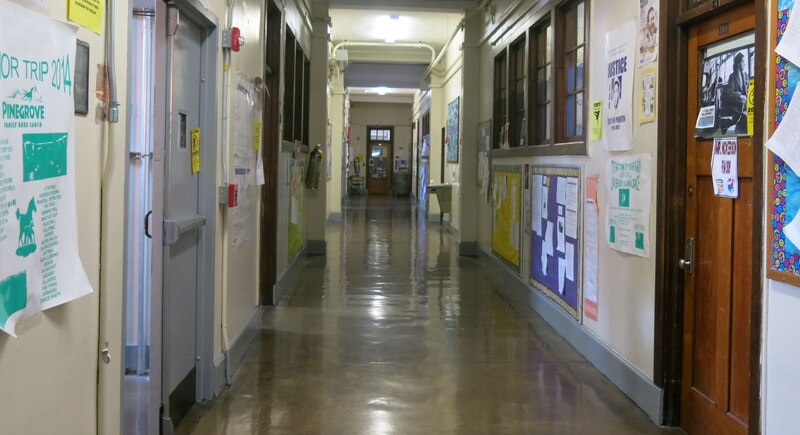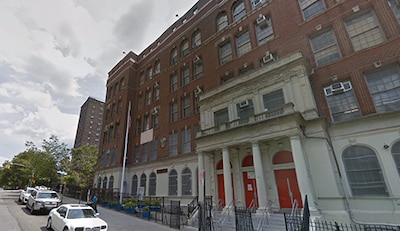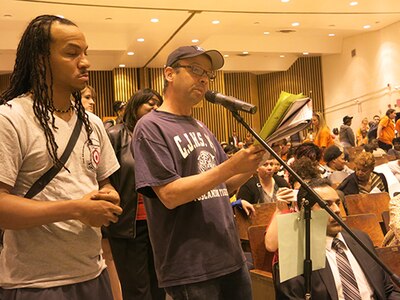
This is the second in a series of stories for our first Raise Your Hand investigation based on the reader-selected question, “Is there a building that houses many schools that are working particularly well together? How are the schools collaborating?”
Inside a six-story Bronx building last spring, 10 students served on a student council to dream up ways their building could be improved. The bathrooms could be better stocked, they decided, and the playground needed to be revamped.
Half of the students in the group were in the older grades at P.S. 55, an elementary school that has served the Claremont Village neighborhood since 1916. The other half attended Success Academy Bronx 2, which shares the building.
The adults in the building say the students’ cooperation largely mirrors their own. The two-school co-location has been held up as a model for years, and it’s also one that frequently surprises outsiders, since Success Academy — New York City’s largest and fastest-growing charter network — has been known for sparking backlash among schools it shares space with.
How has the pairing worked so well? School leaders who respect each other and are willing to work with teachers outside of their own schools; facilities large enough to require compromises, but not impossible ones; and time to grow accustomed to the other school are key, educators said. As the charter sector, and Success Academy, continues to expand, their answers are likely to grow even more relevant.
“If you go into a relationship and the walls are already up before you start to communicate, there’s no way you’re going to move an initiative forward,” P.S. 55 principal Luis Torres said.
P.S. 55 and Success Academy, both of which serve elementary school grades, have been sharing the campus since 2012. From the start, the two principals made a point to develop a personal relationship and get a sense of each other’s school communities, meeting before Success Academy moved in. Torres even joined a citywide committee of district and charter-school leaders to gain a better understanding of how charter schools worked.

The schools have also offered tangible benefits to one another. In fall 2012, P.S. 55 teachers were invited to visit the charter school’s first day of class and its orientation for parents and students. Torres called it “an eye-opener.”
“Even before the children are in the building, Success Academy was already prepping students and parents to get them ready for the first day,” he recalled.
P.S. 55 had always hosted its orientation after the first day of school. After seeing the benefit of preparing students and teachers before day one, P.S. 55 began offering orientation for kindergarteners and their parents the week before classes to meet teachers and go over procedures with parents. That has now expanded to all grades, Torres said.
Meanwhile, the charter school has been exposed to the community partnerships that P.S. 55 had cultivated over years, said Vanessa Bangser, principal of Success Academy Bronx 2.
The campus boasts a health clinic, child-care center, and gardens, all of which have been boosted by outside partners. Just last month, the campus received a $1 million grant to upgrade its playground from Bronx Borough President Ruben Díaz, Jr., who Torres said he has a “great working relationship with.”
Torres “is very talented at making community partnerships and bringing opportunities in the building,” Bangser said. “He always makes sure that we know what’s going on.”
As school leaders in shared buildings across the city know, however, a positive relationship isn’t a given.
Walk less than a mile from the P.S. 55 building down Park Avenue and you’ll find another Success Academy co-location about to begin — one where the district schools’ worry about their survival may make tensions more likely to emerge.
Success Academy Bronx 3, where classes have already started for the year, just opened inside a building with three district middle schools: J.H.S. 145, Urban Science Academy, and New Millennium Academy. The three schools, which serve students older than Success Academy’s, are also under considerable pressure from the city and state to improve. All three are a part of the city’s new “School Renewal” turnaround program because of their low English and math proficiency rates, and face the prospect of significant changes or closure if they don’t meet the city’s goals.

Parents, teachers, and Panel for Educational Policy members have worried that funding and resources attached to the Renewal program will be jeopardized by the schools’ loss of space. City officials have denied that, but district parents filed a lawsuit to try to prevent the new addition to the campus.
“In my experience, all co-locations are difficult,” panel member Norm Fruchter, who is also a senior policy analyst at the Annenberg Institute for School Reform, said while discussing the proposal in April. “We have a huge amount to work to make those schools improve, and we’re going to make it more difficult by introducing a charter school.”
The city’s (often disputed) space estimates showed the building was serving about about half the number of students it could be last year. Still, when one school is growing and another is facing the threat of closure, some said the arrangement feels hostile even if the education department’s space calculations say there is room for everyone.
Jim Donohue, who has taught at J.H.S. 145 for 16 years, said the new school will be the latest challenge for the three schools, which have been struggling to coordinate ever since the building’s original middle school was split up.
“It did get to a point where we could co-exist,” Donohue said, but “the arrival of the charter school sort of unified the building like nothing else has.”
